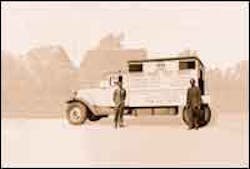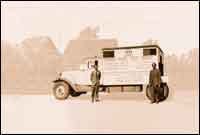The Great Truck Run of 1931
With today's high fuel prices, it would be hard for us to believe that a truck once drove coast-to-coast on $11 worth of fuel. But in 1931, the "impossible" happened.
In that year, Clessie Cummins, inventor and founder of the company that bears his name, continued toward his goal of promoting the diesel engine as the way of powering trucks. His idea: Complete a New York to Los Angeles endurance run in record time in a truck powered by a Cummins diesel engine. Truck endurance runs had been staged before, but with gasoline engines. Cummins hoped to impress the country with the efficiency and durability of diesel engines.
A specially built truck was fabricated in Indianapolis and included two beds, a storage bin and stove in the truck's cargo hold. Three driver-mechanics would make the run, including Clessie Cummins himself. The Continental Oil Co. was enlisted to supply both fuel oil and at least one hot meal a day. Times would be wired back to New York from pre-arranged checkpoints.
The truck left New York in early August 1931. Problems quickly ensued. While crossing the Allegheny Mountains, the truck's brakes began to weaken. In southern Illinois, the cooling system sprang a leak, overheating the engine. A temporary repair was made using shingles from a roadside shed. The truck proceeded to St. Louis, where a new fuel pump was brought in from the Cummins factory in Columbus, Ind.
A special obstacle presented itself as the trip went on. Bridges in rural areas were not built to handle trucks. A truck making an earlier coast-to-coast run is said to have collapsed 43 bridges and culverts along the way. The Cummins truck didn't collapse any bridges but did have to make numerous detours because of washed-out bridges. It made at least one emergency stream fording near Amarillo, Texas.
The truck and crew were forced to endure other problems as they headed west. In one day, a rocker arm failed and a cabin fire occurred. Other than burnt cabin seats, no serious damage was sustained. The most hair-raising experience took place as the truck, with its brakes failing, drove downhill through the Cajon Pass near Barstow, Calif. As the truck gained speed, Clessie Cummins, who was driving, spotted a freight train directly ahead. He frantically began downshifting in an attempt to slow the truck and avoid a collision. The train's caboose cleared the crossing just as the truck reached it.
Even though the truck registered an average speed of just 33.03 mph, the truck nevertheless made the cross-country run in 125 hours, 52 minutes, with a running time of 97 hours, 20 minutes. This beat the gasoline record of 103 hours, 59 minutes running time set earlier by General Motors. More importantly, the truck averaged 15.75 miles per gallon. The fuel cost of the 3,214-mile trip was $11.22.
The cross-country trip accomplished Clessie Cummins' goal. Truck fleet owners took notice of the impressive statistics. The run generated plenty of publicity, and truck owners now were seeing the benefits of the diesel.
Information provided by Cummins Engine Co. from the book "The Engine That Could" by Jeffrey L. Cruikshank and David B. Sicilia.

